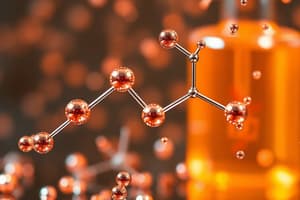Podcast
Questions and Answers
What is the symbol for Palladium?
What is the symbol for Palladium?
- Cd
- Sn
- Pd (correct)
- Ag
What is the symbol for Silver?
What is the symbol for Silver?
- Pb
- Xe
- Au
- Ag (correct)
What is the symbol for Cadmium?
What is the symbol for Cadmium?
- Ba
- Si
- Cd (correct)
- In
What is the symbol for Indium?
What is the symbol for Indium?
What is the symbol for Tin?
What is the symbol for Tin?
What is the symbol for Antimony?
What is the symbol for Antimony?
What is the symbol for Tellurium?
What is the symbol for Tellurium?
What is the symbol for Iodine?
What is the symbol for Iodine?
What is the symbol for Xenon?
What is the symbol for Xenon?
What is the symbol for Caesium (Cesium)?
What is the symbol for Caesium (Cesium)?
What is the symbol for Barium?
What is the symbol for Barium?
What is the symbol for Lanthanum?
What is the symbol for Lanthanum?
What is the symbol for Cerium?
What is the symbol for Cerium?
What is the symbol for Praseodymium?
What is the symbol for Praseodymium?
What is the symbol for Neodymium?
What is the symbol for Neodymium?
Flashcards
Palladium (Pd)
Palladium (Pd)
A rare, precious metal known for corrosion resistance; used in catalytic converters and jewelry.
Silver (Ag)
Silver (Ag)
Metal known for high conductivity and antibacterial properties; used in electronics and jewelry.
Cadmium (Cd)
Cadmium (Cd)
A toxic metal used in batteries and coatings; raises environmental and health concerns.
Indium (In)
Indium (In)
Signup and view all the flashcards
Tin (Sn)
Tin (Sn)
Signup and view all the flashcards
Antimony (Sb)
Antimony (Sb)
Signup and view all the flashcards
Tellurium (Te)
Tellurium (Te)
Signup and view all the flashcards
Iodine (I)
Iodine (I)
Signup and view all the flashcards
Xenon (Xe)
Xenon (Xe)
Signup and view all the flashcards
Caesium (Cs)
Caesium (Cs)
Signup and view all the flashcards
Barium (Ba)
Barium (Ba)
Signup and view all the flashcards
Lanthanum (La)
Lanthanum (La)
Signup and view all the flashcards
Cerium (Ce)
Cerium (Ce)
Signup and view all the flashcards
Praseodymium (Pr)
Praseodymium (Pr)
Signup and view all the flashcards
Neodymium (Nd)
Neodymium (Nd)
Signup and view all the flashcards
Study Notes
Elements 46-60 Overview
- Palladium (Pd): A rare, precious metal used in catalytic converters and jewelry, valued for its resistance to corrosion.
- Silver (Ag): Known for its conductivity and antibacterial properties, used in electronics, photography, and jewelry.
- Cadmium (Cd): A toxic metal primarily used in batteries and coatings, with environmental and health concerns due to its toxicity.
- Indium (In): A soft, malleable metal used in LCD screens and as a solder material for electronics.
- Tin (Sn): Used as a protective coating for other metals and in alloys like bronze; notable for its corrosion resistance.
- Antimony (Sb): Used in flame retardants and alloys; has applications in electronics and batteries.
- Tellurium (Te): Utilized in metallurgy and as a semiconductor in solar cells; rare in nature.
- Iodine (I): Essential for thyroid function in humans, it is used in medicine and as an antiseptic.
- Xenon (Xe): A noble gas used in high-intensity lamps, as well as in some types of ion propulsion systems for spacecraft.
- Caesium (Cs): A highly reactive alkali metal, used in atomic clocks and as a timekeeping element in GPS.
- Barium (Ba): Commonly used in medical imaging and as a contrast agent, it has applications in fireworks and glassmaking.
- Lanthanum (La): Utilized in camera and projector lenses, and in catalysts used in petroleum refining.
- Cerium (Ce): Used in catalytic converters and glass polishing, holds important properties for metallurgy.
- Praseodymium (Pr): Used in magnets, lasers, and glass coloring; has significant magnetic properties.
- Neodymium (Nd): Known for its powerful magnets, widely utilized in electronics, motors, and optics.
General Characteristics
- Metals in this group vary widely in usage and applications, covering fields such as electronics, photonics, medicine, and materials science.
- Many of these elements are crucial in high-tech applications and have significant industrial importance.
Studying That Suits You
Use AI to generate personalized quizzes and flashcards to suit your learning preferences.




